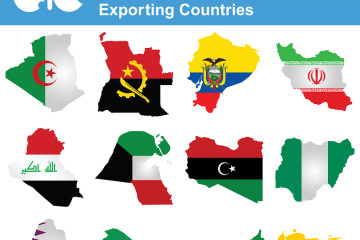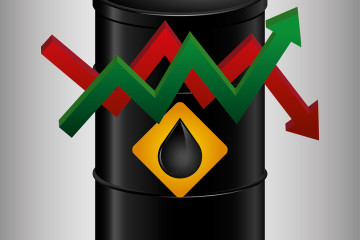Oil Slides Under $35 as Glut Worsens While Fed Sinks Commodities

©2015 Bloomberg News
NZJ9AJ6S972B
NZJ9AJ6S972B
(Bloomberg) — Oil traded below $35 a barrel and headed for a third weekly decline amid a worsening U.S. supply glut and the first interest rate increase by the Federal Reserve in almost a decade.
Futures held losses in New York after closing Thursday at the lowest in almost seven years, and were down 2.4 percent this week. Crude stockpiles surged to 490.7 million barrels, the highest for this time of year since 1930, according to the Energy Information Administration. Goldman Sachs Group Inc. warned of “high risks” that prices may sink further as supplies swell. The Fed decision bolstered the dollar, diminishing the investment appeal of commodities.
Oil is trading near levels last seen during the global financial crisis on signs the surplus will be exacerbated. The Organization of Petroleum Exporting Countries abandoned output limits at a Dec. 4 meeting while the White House announced its support Wednesday for a deal reached by congressional leaders that would end the nation’s 40-year restrictions on crude exports.
“The major driver this week has been U.S. dollar strength against a backdrop of ongoing refusal to respond rationally to the current market surplus on the supply side,” Michael McCarthy, a chief markets strategist at CMC Markets in Sydney, said by phone. “We’re just not seeing the normal production cuts we’d expect given the plummet in prices.”
Futures held losses in New York after closing Thursday at the lowest in almost seven years, and were down 2.4 percent this week. Crude stockpiles surged to 490.7 million barrels, the highest for this time of year since 1930, according to the Energy Information Administration. Goldman Sachs Group Inc. warned of “high risks” that prices may sink further as supplies swell. The Fed decision bolstered the dollar, diminishing the investment appeal of commodities.
Oil is trading near levels last seen during the global financial crisis on signs the surplus will be exacerbated. The Organization of Petroleum Exporting Countries abandoned output limits at a Dec. 4 meeting while the White House announced its support Wednesday for a deal reached by congressional leaders that would end the nation’s 40-year restrictions on crude exports.
“The major driver this week has been U.S. dollar strength against a backdrop of ongoing refusal to respond rationally to the current market surplus on the supply side,” Michael McCarthy, a chief markets strategist at CMC Markets in Sydney, said by phone. “We’re just not seeing the normal production cuts we’d expect given the plummet in prices.”
U.S. Glut
West Texas Intermediate for January delivery was at $34.78 a barrel on the New York Mercantile Exchange, down 17 cents, at 10:50 a.m. in Hong Kong. The contract fell 57 cents to $34.95 on Thursday, the lowest close since February 2009. Total volume traded was about 17 percent below the 100-day average. Prices have dropped 35 percent this year, set for a second annual decrease.
Brent for February delivery was 8 cents lower at $36.98 a barrel on the London-based ICE Futures Europe exchange. It has slid 2.5 percent this week.
Brent, the European benchmark crude, closed Thursday at a premium of 79 cents a barrel to WTI for February, the least in 11 months. The spread has narrowed amid speculation the U.S. plan to allow domestic oil to be shipped overseas may ease the nation’s oversupply. Crude inventories have expanded to 130 million barrels above the five-year seasonal average, EIA data showed Wednesday.
Brent for February delivery was 8 cents lower at $36.98 a barrel on the London-based ICE Futures Europe exchange. It has slid 2.5 percent this week.
Brent, the European benchmark crude, closed Thursday at a premium of 79 cents a barrel to WTI for February, the least in 11 months. The spread has narrowed amid speculation the U.S. plan to allow domestic oil to be shipped overseas may ease the nation’s oversupply. Crude inventories have expanded to 130 million barrels above the five-year seasonal average, EIA data showed Wednesday.
Storage Limits
Oil-storage tanks could reach their capacity, pushing prices down to levels necessary to force an immediate halt to some production, Goldman Sachs said in a report Thursday.
“U.S. stockpiles have increased quite significantly, which continues to miss market consensus,” said Yoo Kyung Ha, a commodities analyst at Dongbu Securities Co. in Seoul. “There’s no one in the market who is willing to take a long-position at the moment, making it difficult to remove the supply glut.”
The Bloomberg Commodity Index, which measures the returns on 22 raw materials including oil and metals, declined for a sixth day Thursday to the lowest close since March 1999.
Sixteen of 30 analysts and traders, or 53 percent, were bearish on WTI in a Bloomberg survey Thursday. Eight respondents were bullish and six were neutral.
“U.S. stockpiles have increased quite significantly, which continues to miss market consensus,” said Yoo Kyung Ha, a commodities analyst at Dongbu Securities Co. in Seoul. “There’s no one in the market who is willing to take a long-position at the moment, making it difficult to remove the supply glut.”
The Bloomberg Commodity Index, which measures the returns on 22 raw materials including oil and metals, declined for a sixth day Thursday to the lowest close since March 1999.
Sixteen of 30 analysts and traders, or 53 percent, were bearish on WTI in a Bloomberg survey Thursday. Eight respondents were bullish and six were neutral.
–With assistance from Heesu Lee.
To contact the reporter on this story: Ramsey Al-Rikabi in Hong Kong at ralrikabi@bloomberg.net To contact the editors responsible for this story: Ramsey Al-Rikabi at ralrikabi@bloomberg.net Yee Kai Pin, Ovais Subhani







No Comment